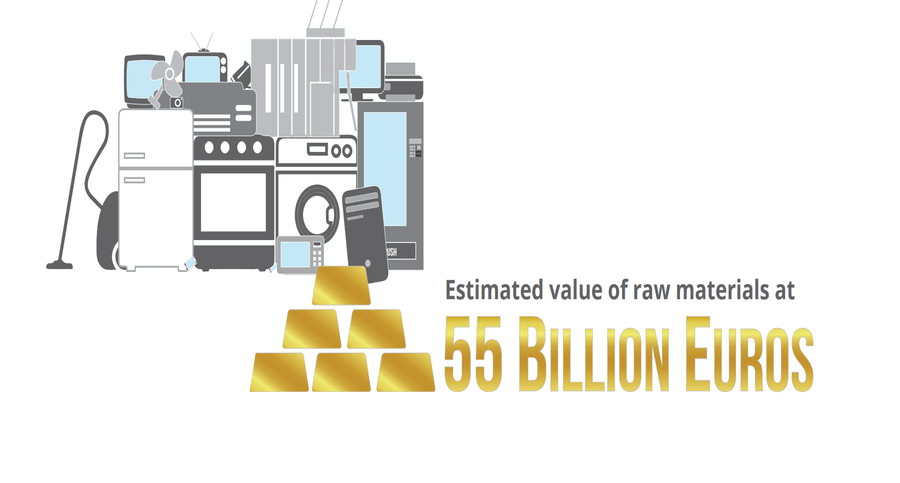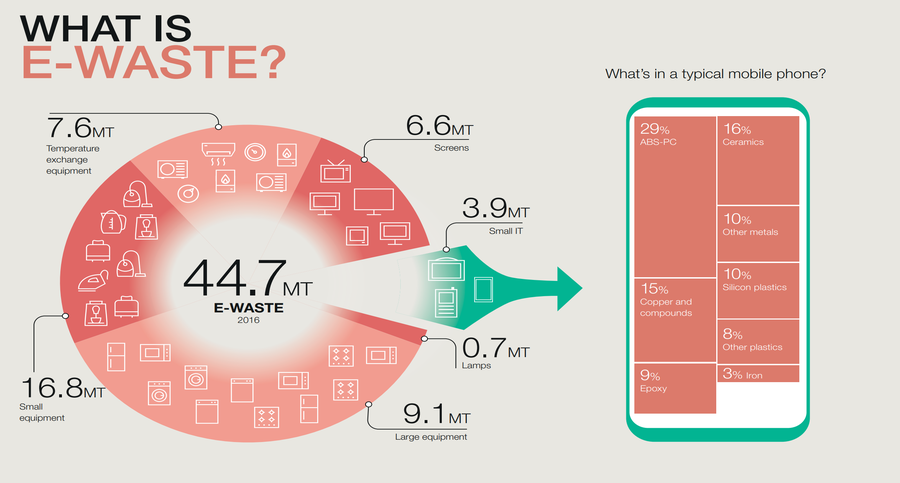The Digital revolution has changed our lives in many ways. Electronic goods, for example, have brought numerous benefits to humankind, offering new opportunities. Yet, at the same time, the current system of production and consumption, and subsequent disposal of electronics represents a huge challenge. E-waste is now the fastest-growing waste stream in the world (World Economic Forum 2019). A “toxic flood of electric and electronic waste” is growing across the world (United Nations labour agency 2019).
How big is it?
The world produces as much as 50 million tonnes of e-waste a year. In 2017, we produced more than 44 million tonnes, which is over six kilograms for every person on the planet. Additionally, the UN expects global electronic waste production to reach 120 million tonnes per year by 2050 if current trends continue (UN Report 2020). This is a huge problem that cannot be neglected because its consequences affect everyone!
In terms of economic value, electronic waste produced annually is worth over $62.5 billion, which is more than the GDP of most countries. The Global E-waste Monitor 2017 estimates that the total value of all raw materials present in electronic waste is approximately 55 Billion Euros in 2016, suggesting that there are huge circular economic opportunities by closing the loop of materials through better design of components, repairing, recycling, reusing, sharing etc. So, e-waste is not just a problem, but an opportunity!

Source: Global E-waste Monitor 2017
Sadly, we only formally recycle 20% of electronic waste. The rest goes to landfill or informally recycled – much of it by hand in developing countries, exposing workers and the environment to hazardous substances.
Electronic waste may represent only two per cent of solid waste streams, yet it can represent 70% of the hazardous waste that ends up in a landfill. E-waste in landfills contaminates soil, air, and water, which contributes to climate change. Therefore, ensuring the safe treatment of hazardous fractions of electronic waste is crucial.
What is e-waste?
You can define E-waste as anything with a plug, electric cord, or battery.

Source: The World Economic Forum
Electronic waste comes from many sources including households, businesses, and governments. As electronic devices are getting cheaper, more people own more devices. In many countries, people own more than one phone and the number of people who own multiple devices, including phones, laptops, and e-readers, is growing.

Need to adopt electronic waste legislation
To address the e-waste challenge, as well as to grasp the opportunity of the circular economy, we need environmentally and socially responsible electronic waste management systems.
Despite a growing number of countries adopting e-waste legislation, many countries lack sustainable collection and recycling systems to handle the hazardous electronic waste.
Unfortunately, in developing countries, electronic waste is generally collected informally and mostly recycled through “backyard recycling” or substandard methods, which can cause severe damage to the environment and human health. Such substandard treatment techniques include open burning to extract metals.
The lacks of legislation and recycling infrastructure are the main reasons that electronic waste is recycled in a crude manner. Currently, 66% of the world population is covered by national e-waste management laws (Global E-waste Monitor 2017).

Source: Global E-waste Monitor 2017
Many countries have initiated a range of efforts to tackle the issue. For example, Ghana implements Sustainable Recycling Industries project to manage wastes through awareness, training, and monitoring the industry through reporting.
More articles are coming on the THRIVE blog about waste if it is your concern! Keep engaging with us to raise awareness!
References,
Ghana Web (2020), “”Electronic waste management project outdoored” available at < https://mobile.ghanaweb.com/GhanaHomePage/business/Electronic-waste-management-project-outdoored-887275>.
The World Economic Forum & The Platform for Accelerating the Circular Economy (PACE) 2019, “A New Circular Vision for Electronics Time for a Global Reboot” available at <http://www3.weforum.org/docs/WEF_A_New_Circular_Vision_for_Electronics.pdf>.
UN report (2020), “Time to seize the opportunity, tackle the challenge of e-waste” available at <https://www.unenvironment.org/news-and-stories/press-release/un-report-time-seize-opportunity-tackle-challenge-e-waste>.
United Nations labour agency (2019), “Turn toxic e-waste into a source of ‘decent work’, UN labour agency urges” available at <https://news.un.org/en/story/2019/04/1036781>.

Pingback: Maintaining your digital well-being: Why it matters - THRIVE blog
Comments are closed.